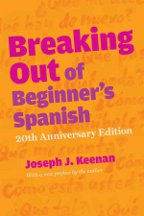Breaking Out of Beginner's Spanish is an excellent supplement for the intermediate Spanish student. Author Joseph Keenan's purpose in writing the book is to help the student become truly fluent in Spanish, using words with their connotative meanings, and polite slang as it is used by native speakers.
Keenan is a journalist who has lived and worked in Mexico for over ten years. Because he is a native speaker of English and has had to go through this exact process of learning to sound less like a "gringo," he understands the pitfalls in achieving Spanish fluency. In fact, he understands these problems much better than a native Spanish speaker would. His explanations are clear and much more practical than the typical Spanish textbook.
Breaking Out is not a textbook, and it will not take the place of a good Spanish text. There is no practice work included, other than Keenan's encouragement to get out there and use your Spanish. But it will help you to sound less like your only contact with Spanish has been the pages of a high school text. Also, this book is far too detailed to be helpful to the first-year Spanish student. Only after the student has mastered the major tenses and has some familiarity with the subjunctive would Keenan's explanations begin to make sense. The style of writing and vocabulary used is definitely for the older student.
The only caution that needs to be given to parents using Breaking Out of Beginner's Spanish with their teens is that Keenan includes a chapter called "Invective and Obscenity." He addresses the fear that it seems he is therefore encouraging students to swear (which he is not) because he believes that there is more danger in not knowing some information on the topic. For example, there are (as in English) seemingly innocent words that have come to have strong sexual implications in Spanish, and it is important to know to avoid these words. As these terms are all collected into one chapter, it is easy enough to avoid this information if you prefer. If you do read it, or your teen does, be sure that you understand that Keenan gives the English translations without pulling any punches. One redeeming point might be that the chapter definitely centers on obscenities rather than blasphemies.
The rest of this book is so helpful that I hope you won't be put off by that one questionable chapter. Keenan's explanation of the subjunctive mood is clearer than any I have seen in a traditional textbook. In fact, it made the subjunctive so interesting that I wanted to go out and find someone to use it on. Another chapter discusses the connotative meanings of sixty-four different verbs. Other topics covered are different levels of formality in greetings, the history of the Spanish language, and that old nemesis of the Spanish student: the differences between ser and estar, saber and conocer, and traer and llevar. If all this makes Breaking Out of Beginner's Spanish sound like an enormous, dry tome that only a linguist could love, be assured that it is not. The book is around 200 pages in length, with chapters short enough to be swallowed in one sitting. A good way to use it would be to assign a chapter a week to be read. Then, when finished, review it as a resource in preparing compositions or have it handy when doing translations. I think you'll want to keep it handy with your dictionary as long as someone is studying Spanish. [reviewed by Kath Courtney]
[Cathy Duffy's note: consider using this along with other resources such as an advanced grammar workbook and some form of actual reading/translation and writing to make a third-year Spanish course. One easy-to-find advanced grammar is Advanced Spanish Grammar: A Self-Teaching Guide by Marcial Prado, published by John Wiley and Sons.]










